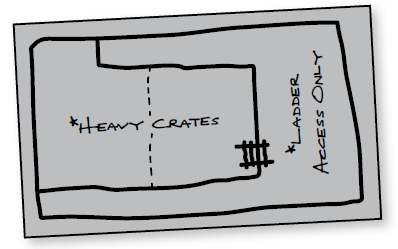While I was pondering whether the new Star Wars RPG by Fantasy Flight Games might be something worse purchasing instead of sticking with Star Wars Saga Edition (the FFG game require three $60 books, of which only one has been released yet; but SE is a d20 game with all the baggage that includes), I considered giving another chance to the generic class-less games that are out there. There’s a lot of praise for Burning Wheel and Savage Worlds, but Fate Core brings with it the huge advantage of being entirely free for download.
I have to admit that I am still not a big fan of Fate Points (Action Points, Bennies, Force Points, Luck Points, whatever you want to call them) and I can say outright that I think using Fudge Dice only has the purpse of selling special dice to me (though the game appears to be perfectly playble with 2d6 instead), but there’s really a lot of ideas in that game that frankly should be in every pen and paper game ever published! It’s not even strictly mechanical stuff, but really just some basic ideas how to approach the creation of character personalties, campaign setups, and encounters. Things that can be applied to probably every RPG that exists.
One thing that I really, really like – as someone who thinks miniatures have no place outside of tactical wargames – is to define the battlefield for encounters as a number of zones. The idea is, that you come up with a location for an encounter and divide it into a couple of zones that represent different kinds of environment. For example, an attack of a small hut could have the zones “Inside”, “Front Porch”, “Back Porch” and “Roof”. On each characters turn, they can move from one zone to another one and still get to take one action. In the first round, you could enter the “Front Porch” zone and then throw a smoke grenade through a window, and in the second round you move from “Front Porch” to “Inside” and try to tackle the enemy. The effect from the smoke grenade would now also affect only the “Inside” zone.
They key aspect of this approach is that you don’t really need any maps. You don’t have to think how many squares or hexes there are in a room, at what angles the walls and doorways are, where furniture is located, and so on. The simple map for a warehouse in the rules looks like this.

The area markes as “Heavy Crates” is large enough to have been made into two zones of roughly equal size but with identical conditions, simply to account for how far any character can move as a “free action”. And note how the map doesn’t show any of the individual stacks of crates. When you approach a game like Fate, it doesn’t matter if your character is standing in the correct square to benefit from cover or not. It’s sufficient to say that you are using a stack of crates or an overturned table as cover.
After having read this, I realized I’ve already did something very similar in my last Castles & Crusades game on monday. The PCs were standing in the courtyard of a ruined keep when they were attacked by undead archers on the roof next to a crumbling tower. Two of the PCs ran to the tower and up the stairs to engage the archers in melee, while the third went into cover behind some rubble to return fire with her bow. I told the two players that it would take them all of their turn to get to the tower and up the stairs, but they would be able to attack the archers in the following round. Basically what I did was turning the environment into three zones. “Courtyard”, “Tower Stairs”, and “Roof”. The two characters could not move from the courtyard to the roof on a single turn, but they could get from the courtyard to the stairs in one turn, and then move from the stairs to the roof and still make one attack on the following round.
Speaking of the ranger who took cover behind ruble is a good cue to also mention environment aspects. Aspects are a major factor in Fate Core, but for now it’s sufficient to say that the zone wasn’t actually just “Courtyard” but “Rubble-Covered Courtyard”. The rubble was a small additional element that both the players and the NPCs could possibly include in their tactics during a fight, which the ranger did.
True, I did all these things in that one encounter without ever having read the Fate Core rules. But I have to admit that it was one of only two encounter areas in that particular play session to which I had applied this treatment. All the others were basically empty square rooms or open grassland (even those encounters in the middle of a forest). But now I think I will use this method for every encounter I will run from here on. You don’t always need to have multiple zones, but I am sure virtually every encounter will become much more interesting if you can think of at least two different zones that each have one noteworthy aspect that could be included in the action in some way. And the best thing is that it is so very simply that you can even make it up on the fly without any previous preparation when the players do something unexpected and a fight breaks out spontaneously.
